PDGF-C/D in Choroidal Neovascularization and AMD Therapy

About the Research Project
Program
Award Type
Standard
Award Amount
$100,000
Active Dates
April 01, 2007 - May 31, 2009
Grant ID
M2007051
Goals
This project will test the role of two growth factors, PDGF-C and PDGF-D, in the development and growth of new blood vessels in the choroids and retina. Inhibition of these molecules may provide possible new therapies for AMD.
Summary
Reagents that can suppress the growth of undesired blood vessels have shown beneficial effects for some AMD patients. However, none of them can halt or reverse the course of the disease. New anti-angiogenic reagents are, therefore, still needed. The platelet-derived growth factor C (PDGF-C) and PDGF-D are two promising candidate molecules to be targeted. Our previous and current work has shown that both PDGF-C and PDGF-D are potent angiogenic factors with potentially important roles in choroidal neovascularization (CNV). This study is thus designed to test the role of PDGF-C and PDGF-D in the development and growth of undesired new blood vessels in the choroids and retina. Multiple approaches, including different CNV mouse models, PDGF-C deficient and transgenic mice, neutralizing antibodies and siRNA, etc, will be used to achieve our scientific goals. Results derived from this study investigating the angiogenic nature of PDGF-C and PDGF-D in CNV formation and progression, as well as the anti-angiogenic effects of PDGF-C/D antagonists alone and in combination with other angiogenesis inhibitors, will provide not only new insights into the basic molecular and cellular mechanisms of CNV formation in neovascular AMD but also possibilities of novel therapy for the treatment of AMD patients.
Related Grants
Macular Degeneration Research
A Novel Implantable Device to Treat Wet Macular Degeneration
Active Dates
July 01, 2025 - June 30, 2028

Principal Investigator
Charles DeBoer, MD, PhD
Current Organization
Stanford University
Macular Degeneration Research
New Drug Delivery Approach to Transform Macular Degeneration Treatment
Active Dates
July 01, 2025 - June 30, 2028

Principal Investigator
Daisy Shu, PhD
Current Organization
University of New South Wales
Macular Degeneration Research
Innovative Night Vision Tests for Age-Related Macular Degeneration
Active Dates
July 01, 2024 - June 30, 2027

Principal Investigator
Maximilian Pfau, MD
Current Organization
Institute of Molecular and Clinical Ophthalmology Basel (Switzerland)



